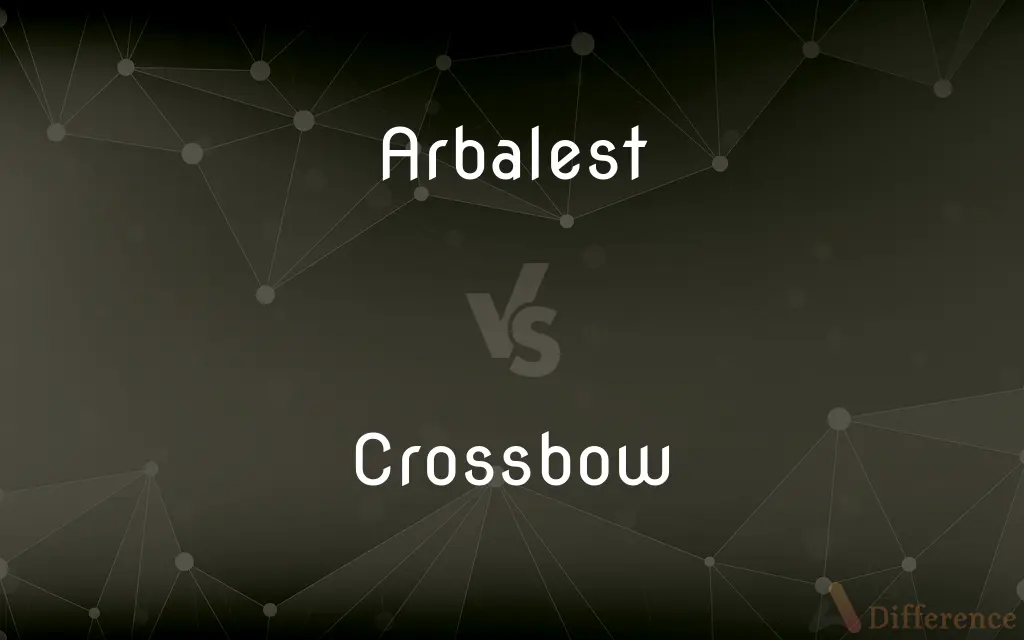Arbalest vs. Crossbow — What's the Difference?
By Tayyaba Rehman & Maham Liaqat — Updated on March 7, 2024
Arbalest is a type of powerful medieval crossbow with a steel prod, while Crossbow is a broader category of ranged weapons consisting of a bow mounted on a stock.

Difference Between Arbalest and Crossbow
Table of Contents
ADVERTISEMENT
Key Differences
An arbalest is a specific type of crossbow known for its great power and range, developed in the late medieval period. It features a heavy steel prod (the bow part), which was a significant advancement over earlier wooden prods. On the other hand, the term "crossbow" encompasses a wide range of bow-like devices mounted on stocks, which have been used for centuries across different cultures and time periods.
The arbalest, due to its construction and the materials used, was capable of launching projectiles with much greater force and to a longer distance than earlier crossbow designs. Whereas, crossbows can vary greatly in size, power, and range, depending on their design and the materials from which they are made.
Arbalests were often used in sieges and battles for their ability to penetrate armor at a distance. In contrast, crossbows have been utilized in various contexts, including hunting, warfare, and as sporting equipment, demonstrating their versatility.
The use of the arbalest required specialized training and significant physical strength, particularly in cocking the weapon, which was often done using a windlass or crank mechanism. Meanwhile, crossbows cover a spectrum of designs, some of which are simpler to operate and do not require the same level of physical strength or training to use effectively.
Despite their differences, both arbalests and crossbows played significant roles in military history. The arbalest for its technological advancements and superior firepower in its time, and crossbows for their enduring presence on battlefields and hunting grounds due to their adaptability and ease of use.
ADVERTISEMENT
Comparison Chart
Type
Specific type of crossbow
Broad category of ranged weapons
Prod Material
Steel, providing greater strength
Varies (wood, steel, composite materials)
Usage Period
Late medieval period
Ancient times to present
Power and Range
High power and long range
Varies widely
Applications
Primarily military, especially in sieges
Military, hunting, sports
Operation
Requires significant strength or mechanisms
Varies from simple manual operation to mechanical
Compare with Definitions
Arbalest
A powerful medieval crossbow with a steel prod.
The arbalest was a feared weapon for its ability to penetrate armor from a distance.
Crossbow
A ranged weapon with a bow mounted on a stock.
The crossbow has been used for hunting and warfare for centuries.
Arbalest
Known for its great power.
Soldiers equipped with arbalests could target enemies from greater distances than those with traditional crossbows.
Crossbow
Seen as a versatile and enduring weapon.
The crossbow's adaptability has ensured its place in both historical and contemporary arsenals.
Arbalest
Associated with technological advancement in medieval weaponry.
The advent of the arbalest marked a significant evolution in siege warfare tactics.
Crossbow
Accessible to a broad range of users, from hunters to soldiers.
Due to its ease of use, the crossbow has been a favored weapon among many cultures around the world.
Arbalest
Used by specially trained operators in military contexts.
Arbalestiers were highly valued in medieval armies for their skill with the weapon.
Crossbow
Offers a wide range of designs.
From simple wooden crossbows to complex steel models, the crossbow's design has evolved over time.
Arbalest
Primarily in medieval warfare.
The arbalest required a windlass for cocking due to its powerful tension.
Crossbow
Versatile, used in various contexts including sport.
Modern crossbows are popular for sport shooting and hunting due to their accuracy and power.
Arbalest
The arbalest (also arblast) was a late variation of the crossbow coming into use in Europe during the 12th century. A large weapon, the arbalest had a steel prod ("bow").
Crossbow
A crossbow is a ranged weapon using an elastic launching device consisting of a bow-like assembly called a prod, mounted horizontally on a main frame called a tiller, which is hand-held in a similar fashion to the stock of a long firearm. Crossbows shoot arrow-like projectiles called bolts or quarrels.
Arbalest
A medieval crossbow, especially one having a steel bow and a winch or other mechanism to draw the string.
Crossbow
A weapon consisting of a bow fixed crosswise on a wooden stock, with grooves on the stock to direct the projectile.
Arbalest
A crossbow.
Crossbow
A mechanised weapon, based on the bow and arrow, that shoots bolts.
Arbalest
A crossbowman.
Crossbow
A portable ballista that can be held in the hand.
Arbalest
A crossbow, consisting of a steel bow set in a shaft of wood, furnished with a string and a trigger, and a mechanical device for bending the bow. It served to throw arrows, darts, bullets, etc.
Crossbow
A weapon, used in discharging arrows or bolts, formed by placing a bow crosswise on a stock.
Arbalest
Medieval artillery used during sieges; a heavy war engine for hurling large stones and other missiles
Crossbow
A bow fixed transversely on a wooden stock grooved to direct the arrow (quarrel)
Common Curiosities
Can a crossbow be as powerful as an arbalest?
While some modern crossbows can match or exceed the power of historical arbalests, traditional crossbows typically had less force and range.
Were arbalests used in any specific historical period?
Yes, arbalests were primarily used in the late medieval period, signifying a technological advancement in warfare.
How does an arbalest differ from a regular crossbow?
An arbalest features a steel prod that allows for greater force and range compared to regular crossbows, which may have wooden or composite prods.
Is special training required to use an arbalest?
Yes, operating an arbalest required specialized training, especially due to the strength needed to cock the weapon and its mechanical complexity.
What is an arbalest?
An arbalest is a powerful type of medieval crossbow with a steel prod, known for its great power and range.
What made arbalests effective in medieval warfare?
Their ability to penetrate armor at a distance made arbalests particularly effective in sieges and open-field battles.
Are crossbows still used today?
Yes, crossbows are still used today, primarily for hunting and sport shooting, thanks to their accuracy and ease of use.
Why did arbalests fall out of use?
The development of gunpowder weapons and advances in military technology eventually made arbalests and other medieval ranged weapons obsolete.
Do modern crossbows resemble ancient arbalests?
Modern crossbows may share some design principles with ancient arbalests, especially in terms of power and range, but they often incorporate advanced materials and technology.
What are the main advantages of using a crossbow?
Crossbows are valued for their ease of use, accuracy, and versatility, being suitable for users of different strengths and skill levels.
Can anyone learn to use a crossbow?
Yes, with proper instruction and practice, most people can learn to use a crossbow effectively.
How were arbalests cocked?
Arbalests were often cocked using mechanical aids like windlasses or cranks due to the high tension of the steel prod.
What types of projectiles do arbalests and crossbows fire?
Both arbalests and crossbows fire bolts or quarrels, which are shorter and thicker than arrows used in traditional bows.
Share Your Discovery

Previous Comparison
Exstipulate vs. Stipulate
Next Comparison
Pool vs. BasinAuthor Spotlight
Written by
Tayyaba RehmanTayyaba Rehman is a distinguished writer, currently serving as a primary contributor to askdifference.com. As a researcher in semantics and etymology, Tayyaba's passion for the complexity of languages and their distinctions has found a perfect home on the platform. Tayyaba delves into the intricacies of language, distinguishing between commonly confused words and phrases, thereby providing clarity for readers worldwide.
Co-written by
Maham Liaqat














































